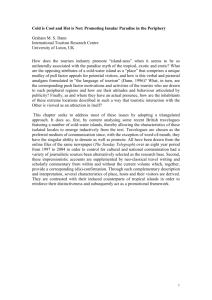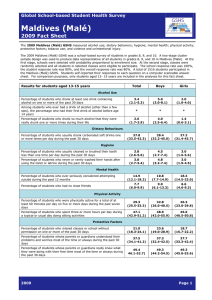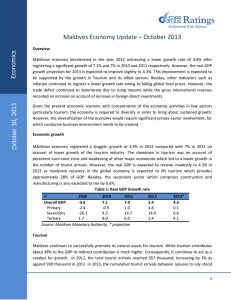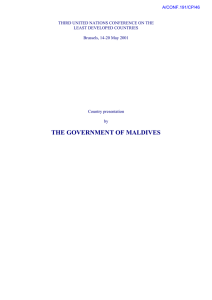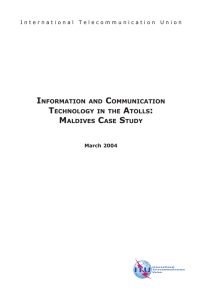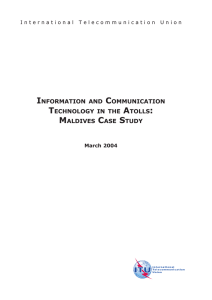Multi-year Expert Meeting on Transport, Trade Logistics and Trade Facilitation
advertisement
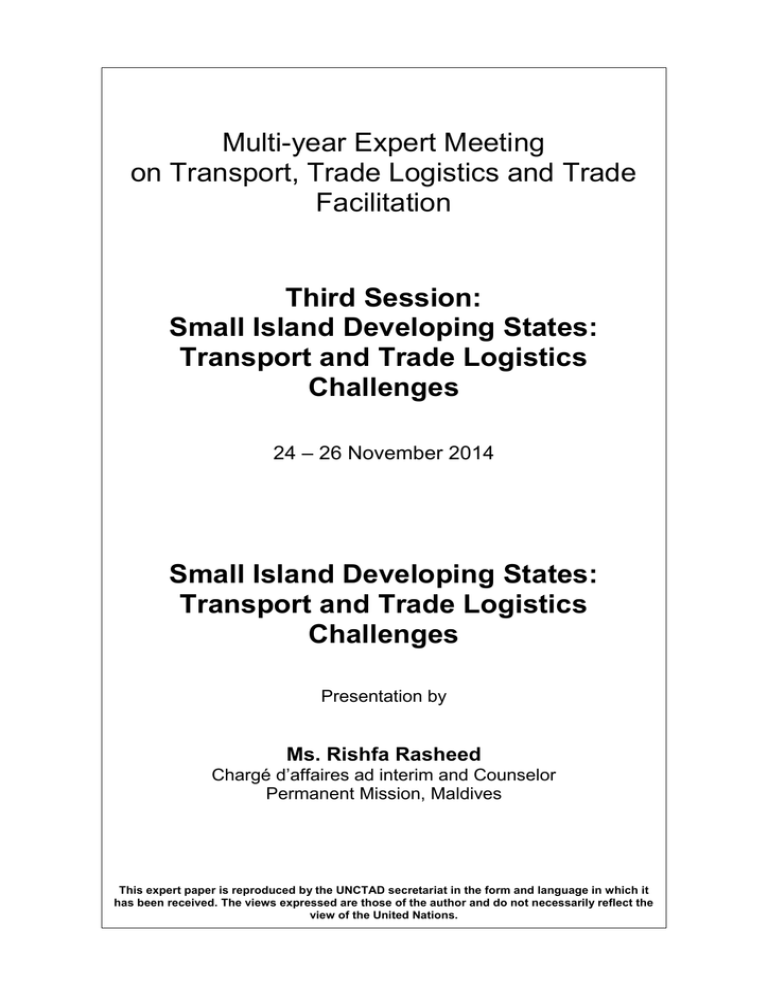
Multi-year Expert Meeting on Transport, Trade Logistics and Trade Facilitation Third Session: Small Island Developing States: Transport and Trade Logistics Challenges 24 – 26 November 2014 Small Island Developing States: Transport and Trade Logistics Challenges Presentation by Ms. Rishfa Rasheed Chargé d’affaires ad interim and Counselor Permanent Mission, Maldives This expert paper is reproduced by the UNCTAD secretariat in the form and language in which it has been received. The views expressed are those of the author and do not necessarily reflect the view of the United Nations. 26/11/2014 Small Island Developing States: Transport and Trade Logistics Challenges UNCTAD Multi-year Expert Meeting 24 - 26 November 2014, Geneva Presentat ion b y: Rish fa Rash eed Cou n sellor, Perman en t Mission of Mald ive s The Maldives 1 26/11/2014 Key Characteristics of SIDS Insularity, geographic remoteness, smallness of economies, population and area Highly dependent on key industries such as tourism, fisheries Extensive territorial waters and exclusive economic zones, high export concentration, deep openness to trade, are heavily reliant on imports Significantly exposed to environment related shocks, and climate change and associated threats, compared to other states Due to dispersion of population as well as the needs of tourism, transportation links need to be well established Food security is dependent on transport links High cost of internal and international transportation National Context Transport Resources: Traditional mode of transport within the islands has been by foot. By 1992, a total of 45,236 vehicles were registered in the Maldives (85% bicycles). By 2010, one in six residents in the capital Malé owned a motorbike. Registered cars increased from 623 to 3,488. Walking is NOT popular. Bus services are operated city wide within Malé City and HulhuMalé. The only roads of significant expanse in the Maldives are located in Addu City and in Laamu Atoll, interconnected via causeways. Both have approximately 14 kilometres of roads 2 26/11/2014 National Context Transport between the islands is by sea – traditional dhoni All inhabited islands and tourist resorts have infrastructure developed in the form of harbours or jetties An integrated ferry network covering all the islands and atolls of the Maldives was initiated in 2008 Actual implementation, efficiency of the system in many regions remains an issue Interconnection of the islands is expected to bring economic benefits and development of other sectors Health education utilities 3 26/11/2014 Sea transport Dhonis (local boats) and speed boats are the most popular forms of inter-island transport Three international ports have been established, One in the capital Malé Two regional ports Haa Dhaalu Kulhudhuffushi in the north, and Addu City in the south Figure 1: Number of vessels by type - 1990 and 2011 Source: transport.gov.mv 10000 9,597 9000 8000 7000 6,293 6000 1990 5000 2011 4000 3000 2,083 2000 649 1000 61 129 297 521 198 155 0 Yatch dhoni Speed launch Boats Dhoni Bahtheli 4 26/11/2014 Air travel - Domestic Domestic airport facilities exist in nine regions Home to the largest sea plane operations in the world In 2011, a total of 112,847 domestic flights were operated for 737,840 arrivals and 747,424 departures 44 planes operating more than 100,000 flights each year in the country Access facilities for sea planes have been established in 66 locations First International Airport opened in 1966 International flights increased from 1,650 in 1990 to 19,435 in 2011 Three additional international airports were opened recently 5 26/11/2014 Air transportation – International Major gateways – Colombo, Doha, Dubai, Singapore International carriers Singapore Airlines, Qatar, Emirates, Sri Lankan, Turkish Airlines Main source markets – Far East (China, Japan etc.), Europe (German and Italian markets are of particular importance) The Far East has displaced Europe and a primary source market for the Maldives Premium airlift have also driven demand for premium hotel brand Figure 2: Passenger movements at international airports (Source DNP, 2012) 1,200,000 1,000,000 800,000 1990 600,000 2011 400,000 200,000 0 International arrivals Transit passengers 6 26/11/2014 Tourism resources: Started in 1972 with two resorts having a bed capacity of 280 Now, one third of GDP and public revenue Among the biggest employment sources Major source of foreign exchange In 2012, 958,027 tourists arrived 343 registered tourist establishments 105 resorts 20 hotels 60 guest houses 158 safari vessels Figure 3: Bed occupancy of resorts 25000 15000 10000 5000 2011 2010 2009 2008 2007 2006 2005 2004 2003 2002 2001 2000 1999 1998 1997 1996 1995 1994 1993 1992 1991 1990 1989 1988 1987 1986 1985 1984 1983 1982 1981 1980 1979 1978 1977 1976 1975 1974 1973 0 1972 Resort bed Capacity 20000 7 26/11/2014 Key Challenges and Way forward 1. Demand for better transportation services to cater to tourism 2. High Energy intensive Tourism Sector due to transportation costs 3. Transport and Tourism inexplicably linked 4. All activities related to tourism are linked to transport linkages 5. Difficulty in maintaining infrastructure across archipelago 6. Environmental impacts on all transportation modes 7. Regulatory framework and institutional reform 8. Remoteness from major markets Overcoming challenges Tourism has been only high-end and luxury Recently started allowing “budget” airlines and “guest-house” tourism Improving the quality and affordability of transport facilities Access to major source markets for tourism Catering to local produce to reduce costs Regional transport facilities Assessing the environmental impact and challenges – sustainable measures Maldives seeks to become a “Carbon neutral country” by 2020 8 26/11/2014 Thank You 9



